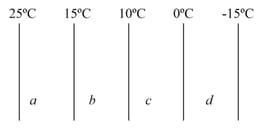Embibe Experts Solutions for Exercise 5: Assignment
Embibe Experts Physics Solutions for Exercise - Embibe Experts Solutions for Exercise 5: Assignment
Attempt the free practice questions from Exercise 5: Assignment with hints and solutions to strengthen your understanding. Gamma Question Bank for Engineering Physics solutions are prepared by Experienced Embibe Experts.
Questions from Embibe Experts Solutions for Exercise 5: Assignment with Hints & Solutions
In an experiment with a continuous flow calorimeter, an input power of produced a rise of in the liquid. When the power was tripled, the same temperature rise was achieved by making the rate, of flow of liquid $n$ times its initial value. If the power lost to the surrounding in each case is , value of is
A brass rod and an aluminium rod each of length and same cross section area are placed in contact with each other as shown. Temperature of both the rods is raised by . The coeffcients of linear expansion of brass and aluminium are and respectively. If the Young's moduli of brass and aluminium are and respectively then stress in the rods is

Two metallic rods of equal length and cross-section but thermal conductivities and are welded together end to end. The resulting thermal conductivity of this resulting rod will be
A metal sphere having inner radius a and outer radius has thermal conductivity . The thermal resistance between inner and outer surface for radial heat flow is
The figure shows the face and interface temperature of a composite slab consisting of four materials, of identical thickness, through which the heat transfer is steady. Which material has maximum thermal conductivity?

The wavelength corresponding to maximum spectral radiancy of a black body is . Consider another black body whose surface area is twice that of and total radiant energy emitted by is times that emitted by . The wavelength corresponding to maximum spectral radiancy for will be
The coefficient of volume expansion for an ideal gas at constant pressure
When the temperature of a body increases from to , its moment of inertia increases from to . The coefficient of linear expansion of the body is . The ratio is equal to
